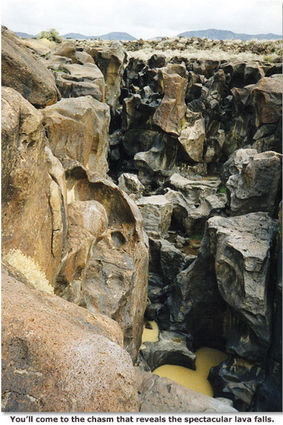Visit Fossil Falls in the Fall
Out 'n' About
You read it correctly. Visit Fossil Falls in the late fall or early spring, as it is 45 miles north of Ridgecrest, east of US 395 and can be hotter than, well you know where.
To clear any possible misconceptions, there are no water falls at Fossil Falls. Over the last 100,000 years the flow from the Owens River, fed by rain and snow was sufficient to form a connected systems of lakes, in the area now known as Mojave Desert basin. Some 20,000 years ago, lava, from volcanic eruptions in the area, flowed into the Owens River channel. The erosion of the volcanic rock formed a porous rock, polished the rock formations, known today as Fossil Falls and it is fascinating to see the polish rock formations.
A red cinder cone, to the north, resulted by a violent ejection of trapped gases and molten material
into the air. The quick cooling formed a porous rock known as scoria, forming a cone shaped hill around the original vent.
10,000 to 20,000 years ago, early cultures inhabited the area, harvesting lake shore resources and hunting large game. By 6,000 B.C. the extreme arid conditions caused marshes and large animals to vanish, causing early human populations to abandoned the area, in the search for food and water.
Circa 4,000 B.C. climate changes shifted to a closer proximity of todays climate. Animals and plants once again established a presence in the area. Today, evidence of human habitation in the area is supported by rocks and boulders worn smooth by the an action used in the processing of plant materials. The rocks are called metates and the hand-held cobble was called a miano. The grinding motion produced a smooth concave surface of the metate. Today we know these as mortar-pestles.
A black scar seen on the dome-shaped hill to the east, is a mile-long seam of volcanic glass or obsidian. Obsidian was used to fashion stone tools such a knives, scrapers and arrowheads. A scattering of obsidian waste flakes can be found in the area, today.
The Falls are located 45 minutes north of Ridgecrest on the east side of US 395. Access is provided via the Cinder Rd. exit and is 1.5 miles from the paved road. From the parking-lot there is a trail to follow.
Wear sturdy, slip resistant shoes, due to uneven surfaces and carry water for drinking. There are restrooms at the trails entrance but not on the trail. Supervise young children at all times, as the trail leads to the top of a sheer cliff.
Camping is permitted at the Fossil Falls Campground. There are 11 sites and fee is $6 per night. The campground has a restroom, potable water, fire rings and picnic tables. There are no length restrictions on RV's and you may stay up to 14 nights.
This is an archaeological site and all such sites are protected by the Antiquities Protection Act of 1906 and the Archaeological Resources Protection Act of 1979. The 1979 Act provides stiff penalties of illegal activities.
As always when enjoying our greater outdoors: pack it in, pack it out, properly dispose of what you cannot pack out and minimize your footprint as much as possible. Please do not remove any artifacts or reasonable facsimiles, thereof.
The U.S. Department of the Interior, Bureau of Land Managment provided the informtion for this article. For further information call 760-384-8400.





